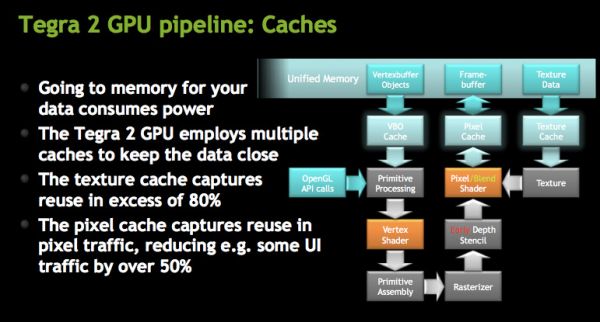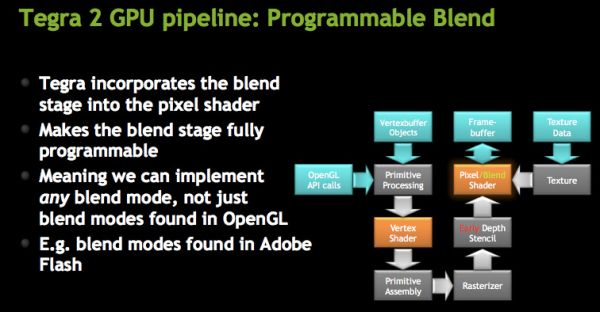LG Optimus 2X & NVIDIA Tegra 2 Review: The First Dual-Core Smartphone
by Brian Klug & Anand Lal Shimpi on February 7, 2011 3:53 AM EST- Posted in
- Smartphones
- Tegra 2
- LG
- Optimus 2X
- Mobile
- NVIDIA
The GeForce ULV
Complementing the three major CPU architectures in the mobile applications processor market for 2011 there are three major GPUs you’ll see crop up in devices this year: Imagination Technologies’ PowerVR SGX Series5 and Series5XT, Qualcomm’s Adreno 205/220 and NVIDIA’s GeForce ULV. There are other players but these three are the ones that will show up in the most exciting devices this year.
ImgTec licenses its GPUs for use in a number of SoCs. Apple’s A4, TI’s OMAP 3 and 4 and Samsung’s Hummingbird all use ImgTec GPUs. The currently used high end from ImgTec is the PowerVR SGX 540, which features four unified shader pipelines capable of handling both pixel and vertex shader operations. The PowerVR SGX 543 is widely expected to be used in Apple’s 5th generation SoC.
The PowerVR SGX as well as Qualcomm’s Adreno GPUs both implement tile based deferred rendering architectures. In the early days of the PC GPU race deferred renderers were quite competitive. As geometry complexity in games increased, ATI and NVIDIA’s immediate mode rendering + hidden surface removal proved to be the better option. Given the lack of serious 3D gaming, much less geometry heavy titles on smartphones today the tile based approach makes a lot of sense. Tile based renderers conserve both power and memory bandwidth, two things that are in very short supply on smartphones. Remember from our CPU discussions that in many cases only a single 32-bit LPDDR2 memory channel has to feed two CPU cores as well as the GPU. By comparison, even PCs from 10 years ago had a 64-bit memory bus just for the CPU and a 128-bit memory bus for the GPU.
NVIDIA believes that the future of GPUs on smartphones is no different than the future of PC GPUs: immediate mode renderers. As a result, the GeForce ULV GPU in NVIDIA’s Tegra 2 looks very similar to a desktop GPU—just a lot smaller, and a lot lower power. It’s also worth pointing out that until we get PC-like content on smartphones, NVIDIA’s approach to ultra mobile GPU architectures may not always make the most sense for power efficiency.
(Note that some of what follows below is borrowed from our earlier coverage of NVIDIA's Tegra 2):
At a high level NVIDIA is calling the GeForce ULV an 8-core GPU, however its not a unified shader GPU. Each core is an ALU but half of them are used for vertex shaders and the other half are for pixel shaders. You can expect the GeForce ULV line to take a similar evolutionary path to desktop GeForce in the future (meaning it’ll eventually be a unified shader architecture).

The four vertex shader cores/ALUs can do a total of 4 MADDs per clock, the same is true for the four pixel shader ALUs (4 MADDs per clock).
The GeForce ULV in NVIDIA’s Tegra 2 runs at a minimum of 100MHz but it can scale up to 400MHz depending on the SoC version:
| NVIDIA Tegra 2 | ||||||
| SoC | Part Number | CPU Clock | GPU Clock | Availability | ||
| NVIDIA Tegra 2 | T20 | 1GHz | 333MHz | Now | ||
| NVIDIA Tegra 2 | AP20H | 1GHz | 300MHz | Now | ||
| NVIDIA Tegra 2 3D | T25 | 1.2GHz | 400MHz | Q2 2011 | ||
| NVIDIA Tegra 2 3D | AP25 | 1.2GHz | 400MHz | Q2 2011 | ||
The AP20H runs at up to 300MHz, while the tablet version runs at a faster 333MHz.
Architecturally, the GeForce ULV borrows several technologies that only recently debuted on desktop GPUs. GeForce ULV has a pixel cache, a feature that wasn’t introduced in GeForce on the desktop until Fermi. This is purely an efficiency play as saving any trips to main memory reduces power consumption considerably (firing up external interfaces always burns watts quicker than having data on die).

NVIDIA also moved the register files closer to the math units, again in the pursuit of low power consumption. GeForce ULV is also extremely clock gated although it’s not something we’re able to quantify.
NVIDIA did reduce the number of pipeline stages compared to its desktop GPUs by a factor of 2.5 to keep power consumption down.
The GeForce ULV supports Early Z culling, a feature first introduced on the desktop with G80. While G80 could throw away around 64 pixels per clock, early Z on GeForce ULV can throw away 4 pixels per clock. While early Z isn’t the equivalent of a tile based renderer, it can close the efficiency gap between immediate mode renderers and TBRs.

The ROPs are integrated into the pixel shader, making what NVIDIA calls a programmable blend unit. GeForce ULV uses the same ALUs for ROPs as it does for pixel shaders. This hardware reuse saves die size although it adds control complexity to the design. The hardware can perform one texture fetch and one ROP operation per clock.
While GeForce ULV supports texture compression, it doesn’t support frame buffer compression.
Both AA and AF are supported by GeForce ULV. NVIDIA supports 5X coverage sample AA (same CSAA as we have on the desktop) and up to 16X anisotropic filtering.
The performance comparison is far more difficult to quantify in the ultra mobile space than among desktop GPUs. There are some very good 3D games out for Android and iOS, unfortunately none of them have built in benchmarks. There are even those that would make for good performance tests however OEM agreements and politics prevent them from being used as such. At the other end of the spectrum we have a lot of absolutely horrible 3D benchmarks, or games with benchmarks that aren’t representative of current or future game performance. In between the two extremes we have some benchmark suites (e.g. GLBenchmark) that aren’t representative of current or future GPU performance, but they also aren’t completely useless. Unfortunately today we’ll have to rely on a mixture of all of these to paint a picture of how NVIDIA’s GeForce ULV stacks up to the competition.
Just as is the case in the PC GPU space, game and driver optimizations play as large of a role in performance as the GPU architecture itself. NVIDIA believes that its experience with game developers will ultimately give it the edge in the performance race. It’s far too early to tell as most of NVIDIA’s partners aren’t even playing in the smartphone space yet. However if PC and console titles make their way to smartphones, NVIDIA’s experience and developer relationships may prove to be a tremendous ally.










75 Comments
View All Comments
SoulShadow - Monday, February 7, 2011 - link
Brian,Do you have any idea if that audio chip will make it into all future Tegra 2 phones, or is this just a lucky phone? Droid Bionic with a Wolfson DAC would make me a happy camper.
Brian Klug - Monday, February 7, 2011 - link
Those specific choices are ultimately left up to the handset makers. It seems to be a relatively common component to select however. I have no idea whether the Bionic or Atrix are getting that same audio IC.We can definitely run RightMark audio analyzer on phones from now on. ;)
-Brian
LostPassword - Monday, February 7, 2011 - link
I travel. Limited bands is disappointing. Waiting for comparisons to HTC dual core. Screw Motorola.HAVM - Monday, February 7, 2011 - link
There is one SoC missing in the 2011 roadmap...Nokia and likely also Sony Ericsson will start to ship smartphones based on the ST-Ericsson U8500 platform in the second half of 2011.
softdrinkviking - Tuesday, February 8, 2011 - link
is that going to be dual-core, or competitive with the tegra/omap/scorpion level socs?kenyee - Monday, February 7, 2011 - link
This is probably the most comprehensive Optimus 2x review I've seen yet, so big kudos.What still bugs me about phone reviews is they don't seem to measure how well GPS receivers work in the phones. Even a simple stick it outside at the same location and see how many satellites show up and how quickly (GPSStatus has a feature that measures time to first fix) would help.
E.g., my crappy Moto Cliq sometimes flakes out and even if it claims it sees 10 satellites, it never gets a fix. It's important for those of us who are using our phones for navigation...
strikeback03 - Tuesday, February 8, 2011 - link
There is a whole section titled "GPS Performance" on page 9, basically comes down to that the hardware seems fine but since it is still preproduction A-GPS wasn't set up.vision33r - Monday, February 7, 2011 - link
Is the iPhone 4, all the other phones all had bulges, plastic, and weird ergo shapes.No wonder the iPhone 4 is sought after more, metal, optical glass, highest resolution, and pixel density count.
azagall - Monday, February 7, 2011 - link
Good performance but the back of the phone is the ugliest I have seen in a while ... And why the plastic ... Isn't this supposed to be a premium phone?texanstc - Monday, February 7, 2011 - link
It looks like I'm not missing much with the LG 2X.